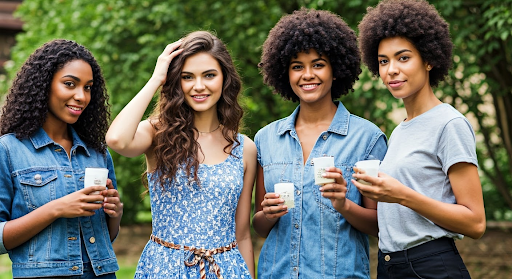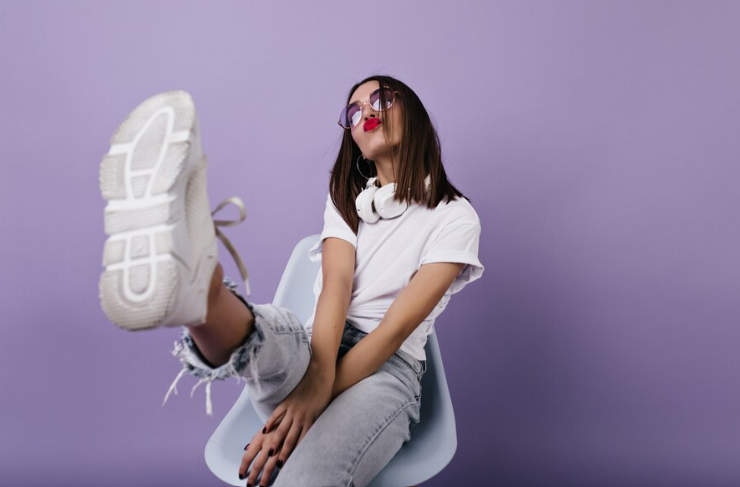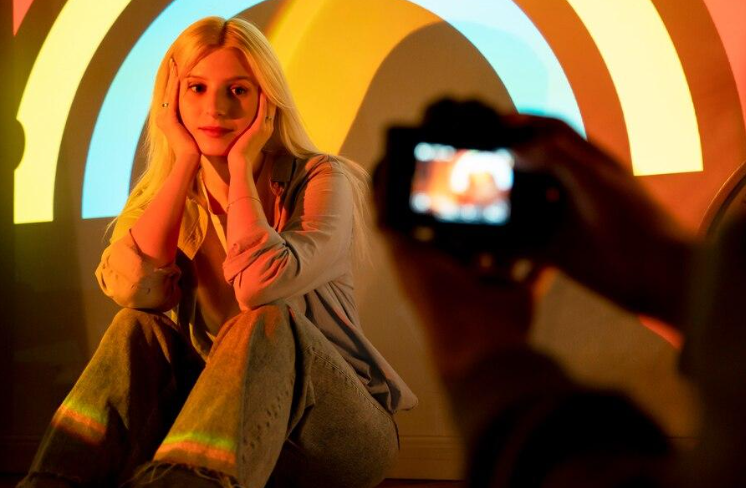With burgeoning ecommerce platforms, businesses have been looking for innovative ways to outshine their competitors and attract potential customers. One significant method that has proven to be highly effective is product photography with models.
Imagine scrolling through an online store and seeing a model gracefully wearing a stylish pair of earrings. It creates a connection, doesn’t it? That’s the power of product photography with models. It adds a human touch to your products—potentially driving up customer engagement and boosting sales.
In this blog, we delve into the world of model photography, discussing why you should invest in it and how to successfully execute a photoshoot with a model. So, if you’re wondering how to elevate your product photography game substantially, continue reading.
What Do We Understand by Product Photography with Models?
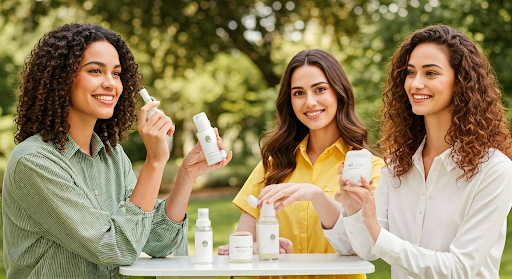
Product photography with models refers to the practice of showcasing products using human models in various real-life settings. It goes beyond mere product depiction; it humanizes the product, depicts its usage, and portrays it in a context relatable to potential buyers. From simple accessories to elaborate apparel, a human element amplifies the appeal, making it much easier for customers to envision the product in their own lives.
Why Should You Invest in Product Photography with Models?
Product photography with models is not just about enhanced aesthetics; it’s a strategic decision that can significantly impact your brand image and sales performance. It helps set the mood, showcases your products in a ‘real-world’ context, and enables potential customers to visualize themselves using the product. Let us unravel some of the compelling reasons to invest in model photography for your products.
Showcases Products in a Real-Life Context
Providing a real-life context to your product will likely pique customers’ interest and facilitate informed decisions. A model wearing a garment or accessories allows customers to gauge how it’d look on them. Moreover, it provides an idea of the product’s size and fit, which is essential when shopping online.
Enhances Emotional Appeal
The right model shot can evoke desired emotions in your target audience by connecting them to your brand story or product’s core benefits. Whether you want to ignite joy, inspire, or evoke the feeling of exclusivity, model photographs can effectively stir up these sentiments, nudging customers closer to purchase.
Increases Engagement
Engagement is imperative in the digital realm. Posts on social media featuring real people tend to generate higher likes, shares, and comments than plain product images, thereby boosting visibility and fostering brand loyalty. So, incorporating models in your product images can be a potent tool to enhance audience engagement.
Improves Product Perception
High-quality model photographs can enhance overall product perception by conveying a sense of professionalism, reliability, and attention to detail. It sends a clear message that you care about your customers’ shopping experience, lending credibility to your brand and products, thus prompting an increase in conversion rates.
How to do Model Photography for Your Products?
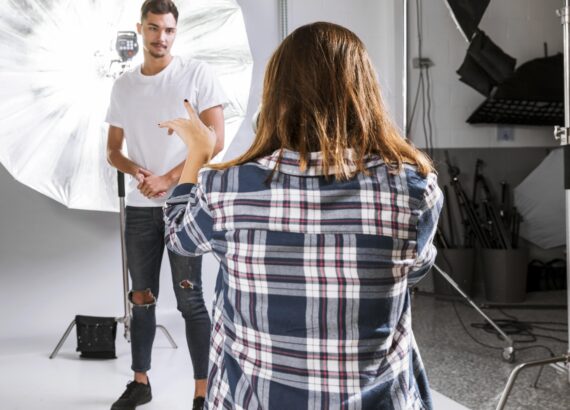
Alt text: Photographer directing model in a studio
Having understood the importance of model photography, the next big question is—how do we proceed with it? You need to consider various aspects like finding appropriate models, deciding the photoshoot location, wardrobe arrangement, collaborating with hair and makeup artists, and hiring professional photographers. Let’s look into each of these elements, offering some practical tips and insights to help you navigate this journey smoothly.
Where to Find Models for Product Photography?
Finding the right model who resonates with your brand image is crucial. Thanks to the digital era, there are plenty of platforms to do so:
- FlixStudio: FlixStudio simplifies model selection for your photoshoot. We offer a diverse range of models, partner with top-tier modeling agencies, and provide a centralized platform for exploring models. Our AI-powered screening system efficiently filters out the best options, saving you time and effort.
- Social Media: Use appropriate hashtags to pinpoint models within your vicinity.
- Local Modeling Agencies: These agencies can provide a range of models fitting your budget and requirements.
Remember, the ideal model should be someone whose appearance aligns with your brand’s target demographic or desired customer persona.
Choosing a Location for the Photoshoot
The location plays a pivotal role in setting the mood and providing the required setting for your product. Professional photographers often have a studio space for rent; simply Google “photography studio rental” along with your city’s name. Alternatively, outdoor or indoor locations like coffee shops, parks, or beaches could add a unique aesthetic appeal and context to your product images.
Arranging Wardrobe
Attire can significantly influence the overall ambiance and tone of your photos, making it an essential aspect to consider. You can shop for appropriate wardrobe and accessories for your model. Experiment with different outfits for different products to create variety, keeping in line with the kind of vibe you intend to portray through your product images.
Collaborating with Hair and Makeup Artists
Makeup plays a crucial role in enhancing the model’s features and elevating the overall visual appeal of the shot. You can find professional MUAs (makeup artists) on platforms. Alternatively, if your model is competent enough to do their own makeup, provide them with specific instructions and a clear brief about the desired look.
Hiring Photographers
Professional photographers possess the requisite expertise and equipment to capture stellar product images. Specific platforms allow you to post free ads and choose from professionals who bid on your requirements. Ascertain that the chosen photographer possesses a credible portfolio, equipment, and aligns with your project goals and budget before finalizing them.
What Guidelines Should You Follow for a Successful Product Photoshoot with Models?
A successful product photoshoot requires meticulous planning and execution. Here are some guidelines to ensure a successful photoshoot with models. Following these steps will help you manage every aspect of the shoot effectively, capturing images that reflect your brand’s quality, value, and style.
Plan the Photoshoot Ahead
Planning forms the bedrock of a successful photoshoot. Devise a step-by-step plan involving important aspects such as:
| Aspects | Remarks |
| Date and time of the shoot | Choose a feasible schedule ensuring lighting conditions are optimal |
| Model and Photographer’s availability | Coordinate with both the model and photographer, keeping a buffer for any last-minute changes |
| Location arrangement | Secure necessary permissions if required and ensure the location is ready for the shoot |
| Wardrobe and Makeup | Coordinate with the model, HMUA (if hired), and stylist to get the desired look |
Pay Attention to Lighting
Lighting can make or break your photoshoot. Good lighting enhances the subject details, texture, and overall visual appeal. Hence, it’s critical to ensure the availability of natural light for outdoor shoots. Likewise, indoor shoots should have adjustable lights that help in achieving the desired mood and focus on the product.
Use Appropriate Props and Backgrounds
Props and backgrounds can add depth and context to the image; therefore, these elements should be chosen wisely. Consider using props that complement your product and reinforce your brand aesthetics. At the same time, avoid cluttering the frame with props or opting for a distracting backdrop, as the product should remain the focus.
Photographer-Model Etiquette
Creating a friendly, professional work environment is vital. Respect the model’s limits, never touch them without permission, and show appreciation for their efforts. Also, effective communication is essential—clearly describe your expectations, listen to their inputs, and maintain open communication throughout the process. A positive work environment greatly contributes to the quality of the end results.
Capture the Moment with Flix Studio
If you’re looking to employ the power of model photography for your products and desire an expert hand in bringing your vision to life, FlixStudio could be a fantastic choice. Harnessing cutting-edge technology and skilled technicians, we meticulously capture every detail and essence of your product. Whether it’s lifestyle photography or in-studio product shots, FlixStudio prides itself on delivering quality that helps enhance brand perception and drive sales performance.
Let’s create something extraordinary together. Contact us at (917) 830-6172 or email info@flixstudio.io
Conclusion
Including models in product photography offers multi-faceted benefits to businesses. From adding a human touch and showcasing products in real-life settings to impacting emotional appeal, enhancing brand perception, and increasing customer engagement—model photography can dramatically uplift your ecommerce performance.
However, achieving stunning model photographs for your products isn’t just about hiring a model and getting started. It requires you to plan ahead, invest time in finding suitable models and photographers, and pay attention to details like location, wardrobe, and makeup, among other things.
In an age dominated by visual content, investing in high-quality product photography with models is no longer just an option but a necessity for businesses aiming to rise above the competition and magnetize potential customers. Employ the power of model photography for your products and offer your audience a highly relatable, visually stimulating, and informative shopping experience.
Frequently Asked Questions
How much do models charge per photoshoot?
Model fees can vary primarily based on their experience and the intricacy of the shoot. Typically, freelance models charge hourly rates ranging from $50 to $200. However, it’s always preferable to discuss and finalize payment terms upfront.
Should a photographer pay a model?
Yes. A model enhances the value of a photoshoot and should be compensated. Some photographers offer a “Time-for-Print” or “TFP” arrangement, where the model receives free photos for their portfolio. However, monetary compensation is always advisable.
How much does product photography cost?
Product photography prices can differ vastly depending on factors like complexity, the experience of the photographer, and additional expenses like model fees, location charges, etc. Ensure that an explicit agreement regarding payment terms is formed before starting the project.
What is model photography called?
Model photography focused on the subject itself is typically referred to as “fashion photography” or “portrait photography.” However, when a model is used to promote a product, it falls within “product photography with models.”

